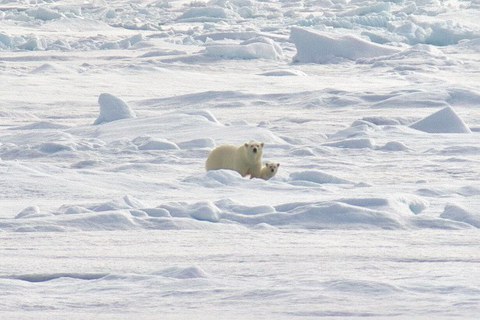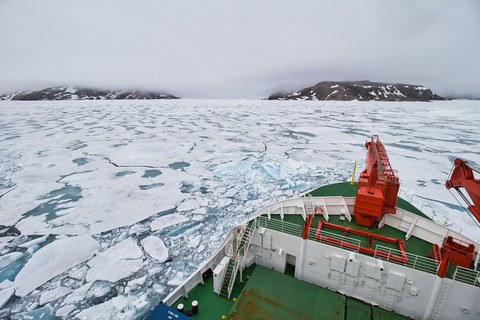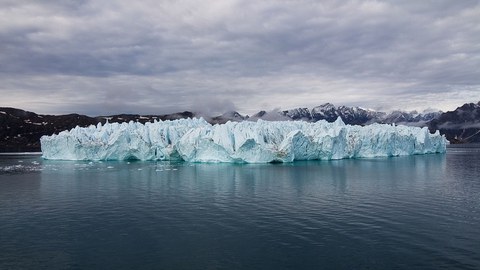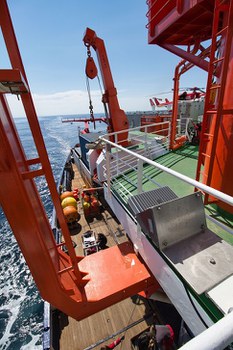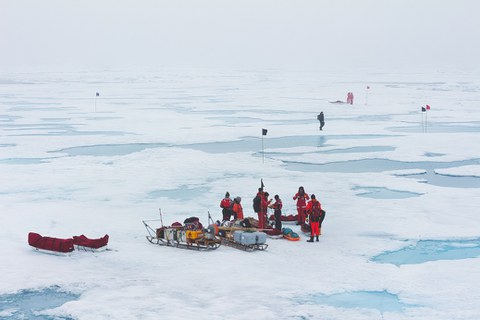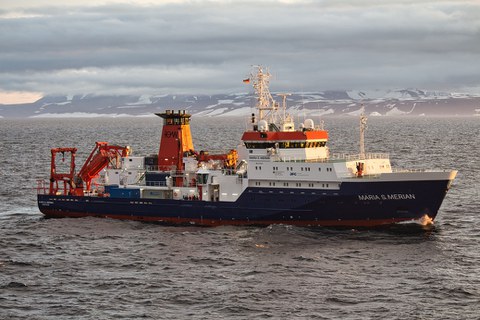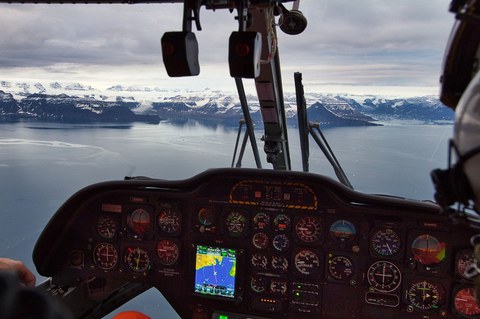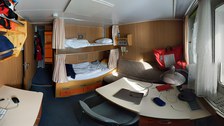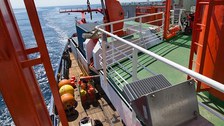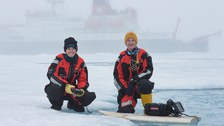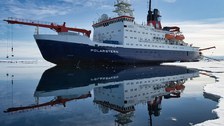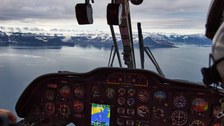Polarstern PS131 NO-Grönland 2022

Polarstern in NO-Grönland
The German research icebreaker Polarstern departed on June 28 from Bremerhaven for the expedition PS131. The cruise leads to the Fram Strait, the marginal ice zone and finally to the Greenlandic Coast near the Nioghalvfjerdsbrae (79°N Glacier), one of the biggest outlet glaciers of the Greenland ice sheet. On board is the Geographer Katrina Bartek (Friedrich-Alexander-Universität Erlangen-Nürnberg) and the Geodesist Erik Loebel (TU Dresden) who regularly report of their work here.
Aims and Program of Work
The aim of the expedition is to carry out geodetic and glaciological measurements on Nioghalvfjerdsbrae and its surroundings.
We will carry out precise GNSS observations at existing stations on bedrock close to the glacier. These observations will be used to determine changes in point coordinates. In particular, we are interested in the elevation change, since it is directly related to the mass change of the Greenland ice sheet. Both the changes since the last glacial maximum as well as present-day ice mass changes have an influence. These mass changes cause deformation of the Earth's crust, which we can measure as uplift or subsidence.
In terms of glaciological processes, supraglacial lakes play a crucial role. While their area can be reliably determined from satellite imagery, lake depth and associated volume are difficult to measure. Therefore, our goal is to determine the depth of supraglacial lakes using a remotely operated survey boat equipped with sonar sensors. These ground truth data will later be fed into algorithms to better determine water depths from multispectral satellite data.
The research is part of the multidisciplinary research project GROCE (Greenland Ice Sheet Ocean Interaction), which has been funded by the German Bundesministerium für Bildung und Forschung (BMBF) since May 2017. A total of 11 subprojects are being carried out by partners from universities and research institutions throughout Germany.
Informationen about Polarstern cruise PS131
After 5 days of self-isolation, numerous Covid-tests and a relatively short trip to Bremerhaven, we boarded the Icebreaker Polarstern on Tuesday morning at around 9 o’clock. After setting up our rooms and eating our first on-board meal, we had enough time to watch the ship’s departure from the upper deck. At around 2 pm Polarstern passed the Bremerhaven Kaiserschleuse into the Weser and a bit later into the North Sea.
Accompanied by excellent weather and a very calm sea, we used the first two days to gather and unpack our freight, set up our small office space (together with the AWI geophysics group) and meet our fellow expedition members. In addition to the ship’s crew, we have 48 cruise participants, mostly scientists but also meteorologists, technicians and helicopter pilots.
The first station of PS131 will be the AWI Hausgarten located in the Fram Strait between Svalbard and Greenland. This regularly observed area is of mayor interest to AWI oceanographers and there are many measurements and experiments planned for this cruise as well. The transit to Fram Strait from Bremerhaven takes about 6 days and leads us through the North Sea along the south-west coast of Norway to the Norwegian Sea and finally into the Greenland Sea. It is estimated that we will arrive there by Tuesday morning. During that time, we have had a few stops testing the oceanographer’s equipment, cranes, winches and net releases.
As of yesterday, with the last round of negative tests, all Covid protective measures were lifted. Now we are allowed access almost all areas of the ship including the master’s bridge, gym, swimming pool and sauna. Additionally, there will be regular and daily science meetings from now on.
Thus, we are looking forward to the next week and send many greetings from Polarstern.
Katie and Erik
On Tuesday Morning, Polarstern arrived at the Hausgarten in Fram Strait. Here the West Spitsbergen Current transports warm Atlantic water northwards into the Arctic. For over twenty years, different oceanographic working groups have been deploying and recovering moorings here. Moorings are long (up to a few kilometers) ropes anchored to the seafloor that have sensors and sampling instruments attached. Usually these moorings stay active for several years measuring temperature and current speeds of the water column and take water samples for biological analysis. In the last days, eight of these moorings have been recovered and redeployed. Consequently, it was very busy at the working deck with people working day and night.
After finishing our work at the Hausgarten, Polarstern will move further north. On Monday we will arrive at the marginal ice zone, the main study area of PS131. Our objective is a multidisciplinary process study of ocean controls on sea ice melt. Similar to MOSAiC, the work constitutes a multi-platform approach, combining mooring-based, ship-based, ice floe-based and helicopter-based measurements.
Excited to see our first arctic ice, we send many greetings,
Katie and Erik
After having successfully completed the work in Fram Strait, Polarstern set course towards the Arctic sea ice on Monday afternoon. Just a few hours later, the research icebreaker is pushing its way bit by bit through the increasingly dense marginal ice zone. While on the bridge, satellite and snow radar images are evaluated in order to find a suitable ice floe, and various working groups are preparing for the upcoming ice work. The plan is to measure and sample three ice floes three times each. The repeat observations will especially contribute to a better understanding of the sea ice melt. The work on ice will be supplemented by a wide array of helicopter-based measurements, especially concerning the surface topography (by means of a laser scanner), melt ponds (multi-spectral cameras are used for this) and the sea ice thickness (by EM Bird).
On Wednesday morning ice work started. The gangway and the crane are used to transport people and equipment onto the floe. As trained polar bear guards, we two are also an integral part of the logistics. With often several shifts a day, we guard our colleagues directly on the ice, from the bridge or from the stern of the ship; so far without polar bear contact. On Thursday and Friday, we successfully visited two more floes. Due to the size and the fragility of the floes, Polarstern wasn’t always able to dock directly, so instead of the gangway, the mummy-chair was used. Up to 8 persons were hoisted onto the sea ice by a working basket and the cargo crane.
Until the repeat observations next week and the week after next week, several days are planned for oceanographic and biological ship measurements.
Many greetings from the arctic,
Katie and Erik
Dear colleagues,
on Monday evening, Polarstern starts another transect through the marginal ice zone. Instead of a multitude of closely spaced stations, this time the new Triaxus system is deployed. The measuring platform is towed through the water behind the icebreaker at a constant 6 knots, repeatedly changing depth and measuring the upper 150 meters of the water column for various oceanographic parameters.
After the transect, about half a day later, we are back in the Arctic sea ice. Thanks to the previously deployed GNSS buoys, we precisely target the already visited ice floes for the first repeat measurements. Besides our work as polar bear guard, on Wednesday we have the opportunity to deploy our remotely operated measurement boat for a first test run.
In coordination with the sea ice group, we survey a larger melt pond, testing the transport, setup, and battery life of our instrument. The converted surfboard moves flawlessly through the water, and the battery lasts for over an hour. Admittedly, the water depth of about 15 cm would not necessarily have required a multibeam sonar. All the more excited we are about the actual deployment on the supraglacial lakes of Nioghalvfjerdsbrae.
Since yesterday evening (Friday) Polarstern has been heading even further north to the Aurora Vent field (about 130 nautical miles northwest). As part of an extensive lithospheric study, ocean bottom seismometers will be deployed at depths of more than 4000 meters to record seismological activity as well as the physical properties of the hydrothermal plume. This work is coordinated and carried out by the AWI Geophysics group.
We send many greetings from 82°40‘N
Katie and Erik
Dear colleagues,
the transit to Aurora, the northernmost point of our research cruise takes 44 hours, significantly longer than anticipated. Although all four available engines are running (so far we have only used two), Polarstern is only slowly dragging itself through the dense pack ice. Again and again we come to a stop and are forced to ram our way through the often kilometer long ice floes. On Monday morning we reach the vent fields and deploy the first of a total of 8 ocean bottom seismometers. The "free fall" of the instruments takes two to three hours and is tracked by an acoustic positioning system. The seismometers will be recovered next year during PS137 via a mooring system that releases when a specific acoustic signal is detected.
Due to the now excellent weather as well as visibility conditions, the first polar bear (or polar bears, it was a mother with cub) was not long in coming - a highlight for us two Arctic newcomers. From a safe distance we observed the giants through our binoculars and telephoto lenses.
After completing the geophysical stations in Aurora, Polarstern sets off on its return journey to the marginal ice zone. Here, the second repeat measurement of our ice floes and the recovery of the deployed instruments are scheduled. Especially the work on the southernmost floe promises to be exciting, as the GNSS buoys installed there have started to drift apart. The disintegration of the ice floes is typical for this time of year.
Next week, probably starting on Wednesday, Polarstern will leave the marginal ice zone and head for northeast Greenland. With this, our scientific program will now also pick up speed. Our working area, on Nioghalvfjerdsbrae and its surroundings, will be reached by shipboard helicopter. For the concrete planning we are already in contact with the helicopter crew and the chief scientist.
We hope for good conditions next week and remain with many greetings
Katie and Erik
Dear colleagues,
already on the approach to northeast Greenland it is clear that the situation in our working area, which is concentrated around the two large outflow glaciers Nioghalvfjerdsbrae and Zachariae Isstrøm, will be problematic. The massive fast ice, which is difficult to navigate through due to its high compactness, extends 70 to 100 nautical miles from the coast of Greenland into the ocean - an exceptional situation for this time of year. The originally planned route of approaching Nioghalvfjerdsbrae from the north is therefore discarded. Instead, we will approach from the south, i.e. from the direction of Zachariae Isstrøm. The fast ice conditions are much better here, so we make relatively good progress and on Friday we are in front of Franske Øer, a small group of islands not far from Greenland. From here it is about 40 nautical miles to the glacier front of Zachariae Isstrøm. Our GNSS stations on Lambert Land (LAMW and LAP1) and a number of supraglacial lakes are within flying distance from here. In the meantime, we prepared the helicopter, the glacier and measurement equipment is sorted and checked several times. Unfortunately, the low cloud cover and the dense fog do not allow for any flight operations. Even a small flight window, in which we could have measured at least some lakes on Zachariae Isstrøm, does not open up. On Sunday there is freezing precipitation as well, thus helicopter flights are practically impossible. We could stay two days longer on site, but the weather outlook for the next few days shows even a worsening of the weather as far as flying conditions are concerned. The decision is made to use the remaining time for other work. On Sunday evening, Polarstern leaves the working area of Northeast Greenland largely undone. The remaining ship time will be spent in Scoresby Sound, on the east coast of Greenland. Here, three oceanographic moorings, which were deployed over 4 years ago, are to be recovered.
Since we have not completely given up hope of achieving at least a partial success of our research project, we use the two days of transit along the east coast of Greenland to plan an alternative program in Scoresby Sound. At least the survey of the supraglacial lakes would potentially be possible here as well. Using current satellite imagery, we map locations of various lakes along the planned cruise route. In addition, we have to apply for a new national park permit and a flight permit. Wednesday night, after a spontaneous meeting with the German research vessel Maria S. Merian (associated with the Institute for Baltic Sea Research in Warnemünde), we reach the mouth of Scoresby Sound - this time in good weather.
Our planning works out and only a few hours later we are sitting in the helicopter flying towards the Brede Glacier on the south side of the main fjord at the Geikie Plateau. However, already during the approach it turns out that the supraglacial lakes on this glacier are covered with a thin layer of ice or ice slush, which makes the operation of our measuring boat impossible. After packing some water as well as snow samples (these will be evaluated later by other working groups for atmospheric analyses), we fly back to Polarstern. Hoping for better conditions we start a second flight in the afternoon - this time to the Eielson Glacier in the western part of Scoresby Sound. Unfortunately, the picture is quite similar. The selected lakes are all covered with a thin layer of ice. Some of them are so transparent that they can only be recognized as such when landing. So in the end we could not make any depth measurements. Nevertheless, we gained valuable knowledge about the dynamics of supraglacial lakes as well as the difficulty to recognize the frozen lake surfaces from satellite images or even from the helicopter.
On Thursday noon, the third oceanic mooring is pulled out of the water; the scientific program of PS131 is thus officially finished and Polarstern takes direct course to Bremerhaven. On the ship, the big clean-up, sorting and packing begins. Laboratories and working areas have to be cleaned and prepared for the acceptance by the 1st officer. The arrival in Bremerhaven is planned for Wednesday morning.
This concludes the expedition PS131, which lasted almost seven weeks. We thank all readers for their interest and send our best regards,
Katie and Erik










